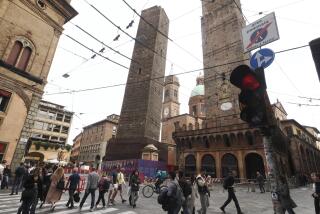Italy’s New Tizzy: Will Tilting Tower of Pisa Topple?
- Share via
PISA, Italy — The Tower of Pisa has been leaning for 800 years, so the keeper of the marble wonder can’t understand what all the latest fuss is about.
It is true that experts have been making dire predictions for years. But there was a real tower tizzy after the minister of public works, Giovanni Prandini, sounded an alarm recently that scared all of Italy.
Newspapers immediately published headlines warning of a “red alert” for the tower, raising fears that one of the symbols of Italy could, at worst, topple, or at best, be closed for repairs.
But Giuseppe Toniolo, chairman of the committee responsible for preservation of the monument, says there is nothing to get excited about.
“There is absolutely nothing new in the situation,” he said in an interview. “To say that the tower is in danger, so what? It’s always been in danger.”
“What does the tower need?” Toniolo added. “It needs to be left in peace.”
The 180-foot circular tower, begun by Bonnano Pisano in 1173, started to tilt almost immediately because the ground shifted underneath. It was completed by Tomasso d’Andrea with the construction of the belfry between 1360 and 1370.
The tower now leans about 13 feet off the perpendicular, but Toniolo and other tower experts say it will not topple for more than another century if it continues to tilt at its average rate.
According to the last measurement in June, the tower leaned an additional .008 of an inch in the last 12-month period. The average yearly tilt since the measurements began in 1918 is .047 of an inch.
“The thing should fall over,” Toniolo said, seated behind a desk in his office, the tower visible through Gothic windows. “How long will this lean last? No one can say. But at a certain time, it will reach the point where it falls. That will take more than 100 years. It could be 200, 250 years.”
For decades, Italy has tried to come up with ways to save the tower. A number of national and international commissions have proposed plans for stabilizing the monument, but none has ever been implemented.
“The problem of trying to stabilize the tower is enough to make the hands of great technicians tremble,” said Gero Geri, a topography professor who has been measuring the lean of the tower since 1969. “Who wants to risk doing something that could upset the equilibrium?”
The latest plan, approved by the government in 1987, is to implant a wheel-shaped support below the base around the tower. It would be connected by concrete spokes to the marble foundation.
The Public Works Ministry appointed a commission a few months ago to study the soil conditions to determine whether the plan can go ahead.
But Toniolo believes the tower can’t be fixed until officials figure out what has kept the 14,000-ton structure standing all these years.
“All the technicians say it can’t be understood,” said the white-haired, 80-year-old retired radiologist who has headed the monument preservation committee for 12 years. “This means there are special conditions of the terrain which haven’t yet been explained. If you can’t understand this, how can you do a project to save it?”
Prandini, a Christian Democrat who recently became public works minister, apparently wants to find a solution.
After expressing his concern over the state of the tower, Prandini ordered a panel of technical experts to report back quickly on the feasibility of a stabilization plan. He also told them to devise a round-the-clock monitoring system for the tower.
Mayor Giacomino Granchi, a Socialist, accused Prandini of exaggerating the situation and trying to get publicity for himself.
Prandini replied, “I don’t see why one wants to make a controversy out of a well-known problem only because there’s the will to act decisively and go from the study phase to concrete realization.”
The sense of urgency was heightened by the collapse in March of the 900-year-old tower of Pavia in northern Italy, killing three people. Experts said the 255-foot tower crumbled either because of natural decay in the mortar holding the bricks together or because of a sudden sinking after a dry spell that lowered the water table.
“The example of Pavia doesn’t count because no one ever monitored it,” Toniolo said. “No other tower in Italy is monitored like Pisa’s. If Pavia had all the instruments that we have, they would have known a few months before” that it was in danger.
Toniolo said he receives an average of 40 proposals a year from people around the world, mostly Americans, for saving the tower.
The latest: erecting a huge statue of Saint Ranieri, Pisa’s patron saint, with arms raised to hold up the tower.
Some even suggest trying to straighten the tower, a notion that makes Toniolo shudder.
“Never, for heaven’s sake,” he said. “It was born tilted. Our ancestors built it that way eight centuries ago. It must remain that way.”
More to Read
Sign up for Essential California
The most important California stories and recommendations in your inbox every morning.
You may occasionally receive promotional content from the Los Angeles Times.













